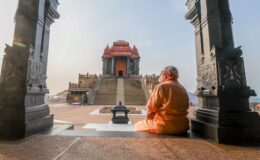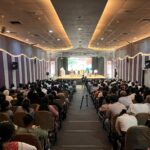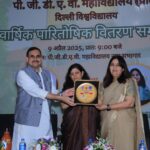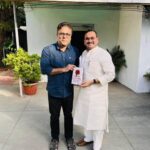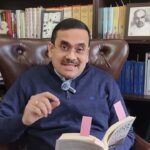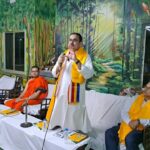SYMBOLISM OF TIRANGA YATRA
- By : Anirban Ganguly
- Category : Articles
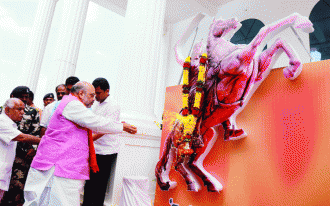
The BJP’s week-long Tiranga Yatra set out a deep message of unity across the country. It talked about four goals viz, protection of national sovereignty, striving to acquire respect in the comity of nations, striving to be materially prosperous and striving to establish a kalyan rajya
The Tiranga Yatra, flagged off by Prime Minister Narendra Modi on August 9 from the birthplace of revolutionary nationalist Chandra Shekhar Azad, ended on August 23. While launching the Yatra, Modi had again called on the youth of India, as he has often done over the years, and had said that “all of us, who may not have got a chance to lay down our lives for the nation, should take the opportunity to live for the nation.” Modi emphasised “that a nation moves forward on the strength of its people, their aspirations, and their hard work.”
The Yatra was timed to commemorate the 70th year of India’s independence and its founding ideal was that of patriotism, nationalism and commemoration of all those freedom fighters — mostly unknown and forgotten — who sacrificed themselves so that as Prime Minister Modi said, “we could breathe the air of freedom.”
The effort radiated a deep message of unity. Seeing Union Ministers, seniors leaders fan out across the country carrying the message of the Tricolour, honouring descendents of revolutionaries, visiting places associated with our struggle for freedom, visiting historic trees, poles, memorials, bridges, lakes, parks — all associated with stories of heroic revolutionary nationalists, one was reminded of Sister Nivedita’s words, in her pithy but profoundly moving essay, ‘The Task of the National Movement in India.’ Nivedita called upon missionaries of patriotism and of nationalism to “travel with the magic lantern, with the collection of post cards, with a map of India and with head and heart full of ballads, stories, and geographical descriptions. Let (them) gather together the women, let (them) gather together the villagers, let (them) entertain them in the garden, in the courtyard, in the verandahs, beside the well, and under the village tree with stories, songs and descriptions of which the refrain is always India! India! India! …This and no other is our Motherland! We are Indians every one!”
For generations, in post-independent India, especially in the last four decades, who have been brought up on an intellectual staple brewed in the ideological kitchens and farms of Marx and Mao, words of Nivedita have remained foreign. In fact, if one were to go by the letters, memos and notes which some of the ‘stalwarts’ of the Communist movement wrote to their colonial benefactors, at the height of the Quit India movement, one would realise the severe disconnect from the vision of the nation and from patriotism that this ideology, its progenitors and its ideological troubadours have engendered in those it has taken over in its thrall. Sample this line from PC Joshi’s detailed note to the then Home Member, Reginald Maxwell written sometime in 1943, “…After August 9, the vast majority of patriots thought the final struggle for national freedom had begun; we alone had the courage and the understanding to expose it as national suicide and go right down to the people to fight for our slogans.”
As one followed the many hues and dimensions of the Yatra, words of nationalist thought-leaders and pioneers of the ‘Swadeshi-Tapasya’ came to mind, words, which in a free and proud nation should have found place in the educational mainstream so that young minds could have learnt to value, and to cherish freedom. One recalled how KM Munshi — philosopher-statesman, nationalist, freedom fighter, polymath — on the eve of freedom contemplated in his diary that a “weak and divided nation…is a temptation to aggressive nations…” and how “a strong national consciousness” and “material strength” was a sine qua nonfor India to remain free. Munshi is one such pre-eminent personality who has faced marginalisation ever since his death in 1971 simply because his politics, worldview, cultural positions did not fit into the Congress-Communist rubric.
The cherishing of freedom can only emerge or grow when a nurturing in the tradition and spirit of the land takes place, when the sacredness of the land, its people and its wisdom is not a mere esoteric mental state, is not derided or negated or deconstructed and discouraged, but is rather encouraged to develop as a deep connect. This means, as Nivedita argued, in the realm of thought “each man must recognise his birth-land as the supreme fact in his life, and must consciously bow himself to her influence, glorying in it, and striving to rediscover and realise it, in its essentials.”
If one were to record, the many experiences of those who participated in the Yatra or led from the front, interesting and moving accounts emerge of how ordinary people continue to remain the principal recorders of the saga of freedom. It also showed how stories of heroism and of sacrifices of countless revolutionaries have been lost in the mist of dynastic politics, engulfed and dissolved in a cesspool of prejudiced narratives. While elite intellectuals are pre-occupied in formatting the intellectual life of this country and in encouraging intellectual secessionism, divisiveness and a mindset that revels in propagating the ideology of national disintegration, it is the ordinary citizens who have preserved the spark of freedom and who continue to aspire and dream of a truly free existence in free India — this collective aspiration and its driving force is what Prime Minister Modi has termed as “Jan Shakti.”
One of the high points of the Yatra was BJP president Amit Shah’s visit to Ullal near Mangalore and the commemoration of the heroic deeds of Rani Abbakka Devi who relentlessly fought the Portuguese marauders in the 1500s. Often in a rush to ram down a certain version of the history of our freedom struggle, the contributions of the many regions of India in the battle for freedom have been lost or omitted. Rani Abbakka Devi’s has been one such legacy and it was heartening to see Shah join in celebrating her life and struggle.
It was Shah’s address at Ullal on four goals or pillars of freedom, on nationalism and patriotism that brought up fundamental points. It is, he reminded his audience, “imperative today to unite against those who, in the name of freedom of expression, are working to divide and dismember the country.” Without “nationalism and patriotism”, he contended no nation or people could aspire to greatness, “inspiration”, he observed, “could only be derived from the lives of these valiant and sacrificing revolutionaries and not from NGOs who sloganeer against the very existence of India.”
Extrapolating from the thoughts of Munshi, Shah spoke of how a free country, trying to fulfil the dream of an ideal state, needed to pursue four goals in its state of freedom. These goals were the protection of national sovereignty alongwith safeguarding its borders, striving to acquire respect and self-respect in the comity of nations, striving to be materially prosperous and culturally vibrant and striving to establish a kalyan rajya — welfare state based on the vision of humanism.
Those busy peddling the agenda of India’s disintegration will naturally oppose these ideals and aims or deride them as false goals. The message of nationalism in our age is to pursue these four goals unequivocally and relentlessly — therein lay the ideals of freedom and the deeper symbolism of the Tricolour.



